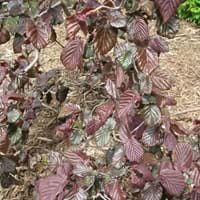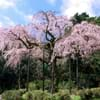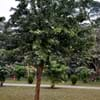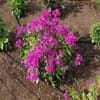Life Span
Perennial
Annual
Type
Flowering Plants, Fruits, Trees
Shrub
Origin
Anatolia, Asia, Europe, Iran, Maghreb, Morocco, Norway, The Hiamalayas
Europe, Northern Africa, Western Asia
Types
Flowering Cherries, Sour Cherries, Sand Cherries, Sweet Cherries, Capulin Cherries
Shrub
Number of Varieties
Not Available
Habitat
Forest edges, Wild, Woods
Woods
USDA Hardiness Zone
4-8
4-8
Sunset Zone
4, 5, 6, 7, 15, 16, 17
2a, 2b, 3a, 3b, 4, 5, 6, 7, 8, 9, 14, 15, 16, 17, 18, 19, 20
Habit
Upright/Erect
Thicket/Colonizing
Flower Color
White
Yellow
Flower Color Modifier
Not Available
Not Available
Leaf Color in Spring
Dark Green
Green
Leaf Color in Summer
Orange
Green, Dark Green
Leaf Color in Fall
Orange
Yellow, Green
Leaf Color in Winter
Orange
Not Available
Plant Season
Spring, Summer
Spring, Summer, Fall, Winter
Sunlight
Full Sun, Partial shade
Full Sun, Partial Sun, Partial shade
Growth Rate
Medium
Medium
Type of Soil
Loamy, Well drained
Clay, Loam, Sand
The pH of Soil
Slightly Acidic
Acidic, Neutral, Alkaline
Soil Drainage
Average
Well drained
Bloom Time
Early Spring, Spring
Early Spring, Spring, Late Winter
Tolerances
Heat And Humidity, Not Available
Not Available
Where to Plant?
Ground
Ground, Pot
How to Plant?
Grafting, Seedlings, Transplanting
Grafting
Plant Maintenance
Medium
Medium
Watering Requirements
Never Over-water, Over-watering can cause leaf problems or root diseases, Prefer drip-irrigation instead of Over-head watering, Water twice a day in the initial period
Average Water Needs, Do Not over Water
In Summer
Lots of watering
Lots of watering
In Spring
Moderate
Moderate
In Winter
Average Water
Average Water
Soil pH
Slightly Acidic
Acidic, Neutral, Alkaline
Soil Type
Loamy, Well drained
Clay, Loam, Sand
Soil Drainage Capacity
Average
Well drained
Sun Exposure
Full Sun, Partial shade
Full Sun, Partial Sun, Partial shade
Pruning
Don't prune in the fall, Prune if you want to improve plant shape, Prune in late winter, Remove dead or diseased plant parts, Remove deadheads
Remove damaged leaves, Remove dead branches, Remove dead leaves
Fertilizers
All-Purpose Liquid Fertilizer
All-Purpose Liquid Fertilizer
Pests and Diseases
Aphids, Bacterial Canker, Black Knot, Brown Rot, Caterpillars
Red blotch
Plant Tolerance
Drought
Drought
Flower Petal Number
Not Available
Not Available
Foliage Texture
Not Available
Coarse
Foliage Sheen
Not Available
Matte
Attracts
Birds
Not Available
Allergy
Swelling in the face
Not Available
Aesthetic Uses
Showy Purposes
Showy Purposes
Beauty Benefits
Not Available
Not Available
Environmental Uses
Air purification
Air purification
Medicinal Uses
Arthritis, Gout, Kidney problems, Rheumatoid arthritis, Swelling
Minerals, Rich in protein, tonic in pregnancy, Vitamin E
Part of Plant Used
Flowers, Fruits
Fruits, Leaves, Seeds, Wood
Other Uses
Wood is used for making furniture
Culinary use, Used for its medicinal properties
Used As Indoor Plant
No
No
Used As Outdoor Plant
Yes
Yes
Garden Design
Not Available
Feature Plant, Foundation, Mixed Border, Topiary, Bonsai, Espalier
Botanical Name
Prunus avium
CORYLUS avellana 'Contorta'
Common Name
Cherry Tree
common hazel
In Hindi
चेरी का पेड़
contorted filbert
In German
Kirschbaum
contorted filbert
In French
Cerisier
noisetier contorsionné
In Spanish
Cerezo
avellana contorsionada
In Greek
κερασιά
παραμορφωμένες φουντουκιού
In Portuguese
árvore de cereja
filbert contorcido
In Polish
wiśniowe drzewo
wykrzywioną leszczyna
In Latin
Cherry
contortis Avellanam
Phylum
Magnoliophyta
Magnoliophyta
Class
Magnoliopsida
Magnoliopsida
Family
Rosaceae
Betulaceae
Clade
Angiosperms, Eudicots, Rosids
Angiosperms, Eudicots, Rosids
Tribe
Not Available
Not Available
Subfamily
Not Available
Not Available
Number of Species
Not Available
Not Available
Importance of Cherry Tree and Contorted Filbert
Want to have the most appropriate plant for your garden? You might want to know the importance of Cherry Tree and Contorted Filbert. Basically, these two plants vary in many aspects. Compare Cherry Tree and Contorted Filbert as they differ in many characteristics such as their life, care, benefits, facts, etc. Every gardener must at least have the slightest clue about the plants he wants to plant in his garden. Compare their benefits, which differ in many ways like facts and uses. The medicinal use of Cherry Tree is Arthritis, Gout, Kidney problems, Rheumatoid arthritis and Swelling whereas of Contorted Filbert is Minerals, Rich in protein, tonic in pregnancy and Vitamin E. Cherry Tree has beauty benefits as follows: Not Available while Contorted Filbert has beauty benefits as follows: Not Available.
Compare Facts of Cherry Tree vs Contorted Filbert
How to choose the best garden plant for your garden depending upon its facts? Here garden plant comparison will help you to solve this query. Compare the facts of Cherry Tree vs Contorted Filbert and know which one to choose. As garden plants have benefits and other uses, allergy is also a major drawback of plants for some people. Allergic reactions of Cherry Tree are Swelling in the face whereas of Contorted Filbert have Not Available respectively. Having a fruit bearing plant in your garden can be a plus point of your garden. Cherry Tree has showy fruits and Contorted Filbert has no showy fruits. Also Cherry Tree is flowering and Contorted Filbert is not flowering . You can compare Cherry Tree and Contorted Filbert facts and facts of other plants too.





